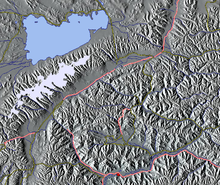Lhasa terrane
| Lhasa terrane | |
|---|---|
| Portion of the terrane, Namtso lake to the north above Nyenchen Tanglha Mountains (white) | |
| Location | Tibet Autonomous Region, China |
| Coordinates | 30°N 91°E / 30°N 91°ECoordinates: 30°N 91°E / 30°N 91°E |
| Geology | Terrane |
The Lhasa terrane is a terrane, or fragment of crustal material, sutured to the Eurasian Plate during the Cretaceous that forms present-day southern Tibet. It takes its name from the city of Lhasa in the Tibet Autonomous Region, China. The northern part may have originated in the East African Orogeny, while the southern part appears to have once been part of Australia. The two parts joined, were later attached to Asia, and then were impacted by the collision of the Indian Plate that formed the Himalayas.
The Lhasa terrane is separated from the Himalayas to the south by the Yarlung-Tsangpo suture, and from the Qiangtang terrane to the north by the Bangong-Nujiang suture. The Lhasa terrane has a Precambrian crystalline basement overlaid with sedimentary strata from the Paleozoic (c. 541–252 Ma) and Mesozoic (c. 252–66 Ma) and containing magmatic rocks from the Paleozoic to Cenozoic (66 Ma to the present). It is thought to be the last crustal block to accrete to the Eurasian plate before it collided with the Indian plate in the Cenozoic.
The Lhasa terrane consisted of two blocks before the Mesozoic, the North Lhasa Block and the South Lhasa Block. The two blocks have lithology and detrital zircon ages similar to the Qiangtang terrane and to Tethyan strata in the Himalaya, which suggests these areas were nearby in Gondwana. The detrital zircon ages differ somewhat between the North and South Lhasa terranes. The South Lhasa terrane appears to have evolved as part of Australia in the late Precambrian and early Paleozoic. Isotopic analysis of detrital zircons of c. 1170 Ma from Paleozoic metasedimentary rocks in the Lhasa terrane shows identical values to detrital zircons of the same age from Western Australia. The detrital zircons probably came from southwest Australia's Albany-Fraser belt.
...
Wikipedia

